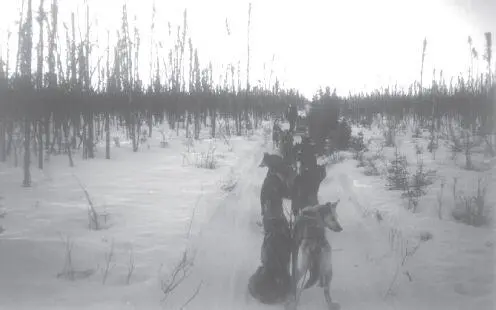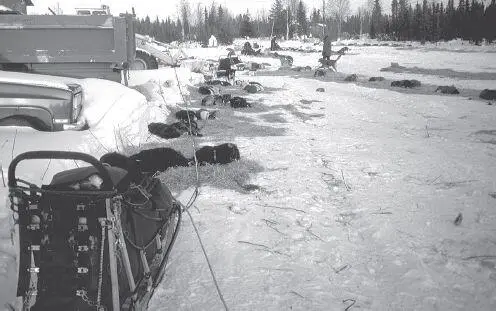Soon the sun sinks below the horizon in a glorious explosion of crimson, orange and blue. Out here on the Burn the sky is so huge the effect is overwhelming. Just after dusk, as we cruise across the flats on a hard, fast trail, I see a dark shape dart onto the trail ahead and then, seeing us, flee back to a safe distance.
It is a very healthy fox which has been scavenging for scraps where mushers have been feeding their teams along the trail. It stays perhaps a hundred yards off the trail and parallels us for almost a mile, hoping for a handout. When we continue, it stops and looks wistfully after us before returning to its vigil for the next team.
In the gathering dusk the team speeds up to 10 miles an hour, a breakneck pace for my Clydesdales. Lisa and I swap the lead every five miles or so as we reel off the miles to Nikolai. Except for a stretch of semi-frozen overflow and a small open creek or two, the trail stays good and the evening is ideal for running.
I vividly recall a particular training run at Montana Creek where I imagined cruising on the far side of the Alaska Range. Tonight is the perfect fulfillment of that vision: the brilliant evening star ahead, the moon rising over the Alaska Range behind me, the twin colossi of Denali and Foraker glowing softly in the last of the alpenglow over my shoulder — and Nome somewhere under the western horizon, much closer than it’s ever been for me before.

The Farewell Burn was the scene of Alaska’s largest forest fire in the summer of 1978. Almost 20 years later much of it is still desolate wasteland. This can be a very treacherous stretch of trail when the wind blows and snow begins to drift. Here Lisa Moore pauses her team ahead of the author’s.
Eventually I drop behind to realign some dogs and arrive in Nikolai not long after midnight. We’ve been on the trail more than 14 hours straight but we’ve pulled through in relatively good shape. Still, the team deserves a rest and the sled needs repairs. I’ve sent out plenty of food and I decide to take my 24-hour layover here instead of in McGrath as I’d planned.
I’ve got plenty of company: eight or ten teams are here finishing up their layovers. Nikolai has become a popular place to rest over the past few years because of its friendly atmosphere and relative quiet compared to the usual media circus in McGrath, 50 miles further on.
After I take care of the dogs I amble down to the checkpoint to see how the race is going. The computer printouts faxed from race headquarters show the leaders are already more than 100 miles ahead, pushing from Ophir to Ruby over what is apparently a horrible trail. Moreover, they’ve all taken their 24-hour layovers, so we back-of-the-packers are really much farther behind than the mileage would indicate. But this isn’t a problem: the leaders are racing for a paycheck; all we want to do is finish, hopefully in decent time. After all, getting there is supposed to be half the fun.
While I make a sandwich in the checkpoint cabin I marvel at the race communications network provided by GCI, one of Alaska’s competing long-distance companies. Every checkpoint has a fax and phone, replacing the ham radio nets of early races. At villages like Nikolai, modern satellite-based phone service has been available for a decade or more, so faxes are nothing new.
At remote checkpoints satellite dishes were flown in along with generators and enough communications gear to make the Pentagon proud. Cripple, which is nothing more than a couple of tents somewhere along the Innoko River at the halfway point of the race, even sports a video phone link back to the race headquarters in Anchorage; of course, it probably will be dismantled by the time we rear-enders get there in a few days.
One nice spin-off for ordinary drivers is people can call from anywhere in the world to race central and have a message faxed to mushers along the trail. Here in Nikolai I find half a dozen messages of encouragement from my family and friends; they’re a real boost and remind me someone is watching no matter how lonely it gets. I’m especially surprised by a message from my sister Ann in New Mexico; it seems I have quite a cult following there and I’m responsible for a significant jump in Internet usage as they hit the Iditarod home page.
Finally I stagger over to the village public works building about five a.m. and hang my parka, overalls, and boots next to the boiler to dry out. Then it’s up to the storage room on the second floor where zonked-out mushers are sprawled everywhere, scattered among boxes, parts bins, and discarded furniture. I find a comfy-looking piece of foam padding and collapse for my first real sleep since several days before the race began, about a million years ago.
March 7. 1996—The Iditarod: 24-hour layover at Nikolai
After a solid rest, I’m up at mid-morning to see to the dogs. Hot water is available in the village washateria located in one end of the municipal office building; this makes feeding the dogs much easier and means we don’t have to fire up our alcohol cookers to heat the water.
While the dog food soaks next to the thumping washing machines I head upstairs to the village community center on the second floor. A tiny restaurant occupies a large serving window with three or four stools at one end of the large room; it hasn’t been open long and the owners are trying to eke out some extra income.

Checkpoints, like Nikolai, offer a chance for teams and drivers to rest and recover. Dogs quickly learn to appreciate the straw and respite from rigors of the trail.
Nikolai is an Athabaskan Indian village of barely 200 people. As in most remote Alaskan Native settlements cash is a scarce commodity, especially in the winter. The Iditarod represents a major boost to the local subsistence-based economy. I’m more than happy to contribute my share for a plate of sausage, eggs, and pancakes.
While I’m eating I get into a discussion with the city administrator, who is white and lives most of the time in Anchorage. He tells me this isn’t an unusual situation for Bush villages. Part of his job is also to secure grants and other financial aid for the village, and this requires experience and connections not readily available from local sources.
For his part, the administrator is as staunch a partisan of the village as any of the locals, and he genuinely seems to understand their unique needs and issues. It seems like a typically practical Alaskan solution to an otherwise intractable problem. As I head out to feed the dogs a camera crew asks if they can do an interview. They’re from Channel 13 in Anchorage, which is teaming up with the cable-based Outdoor Channel for what should be exceptionally good coverage of the race. They have made a promise to cover the tail-enders in addition to the front-runners, a decision I find very refreshing. I’m just surprised to find myself the tail-ender in front of the camera.
For the better part of an hour they follow me around as I feed the dogs, work on the sled, and muse about the Iditarod and life in general. For me it’s quite the bully pulpit, even though I know they’ll probably throw out 90 % of the tape.
Lisa Moore comes over and together we explain exactly why we’re doing this: to finish, period. I’m not sure the reporter has encountered this approach to the race — no money, no glory, just the chance for a run down Front Street and the official finisher’s belt buckle.
Lisa probably puts it best: our race is a series of obstacles. We get past the obstacle at hand and then go to work on the next one, which may be only 20 yards down the trail. We run the race one problem at a time, and sooner or later we’ll get past the last one and finish in Nome. We may ultimately get beaten by forces beyond our control, but we’ll never give up without a hell of a fight. This is the paramount lesson we’ve all learned in our various paths to this year’s race.
Читать дальше














